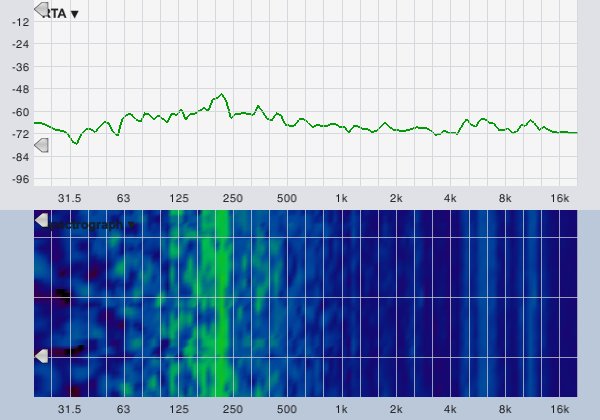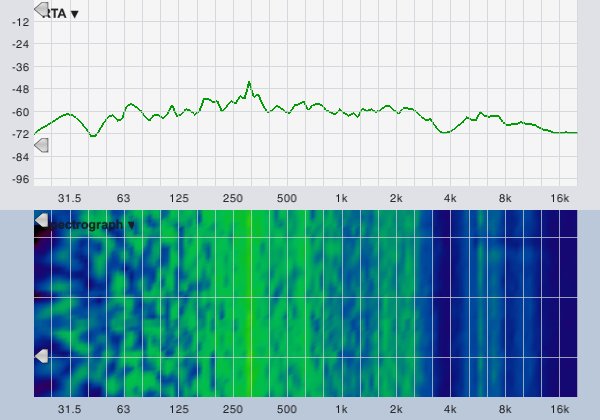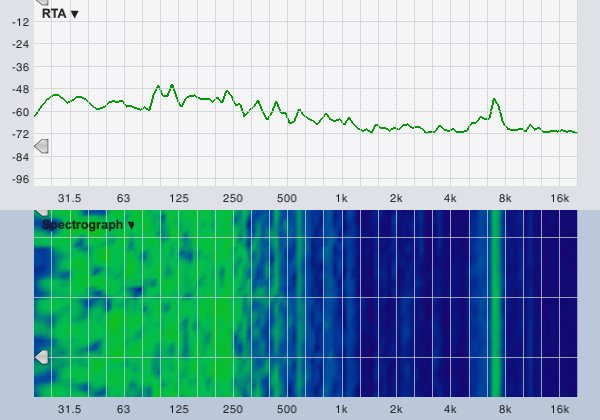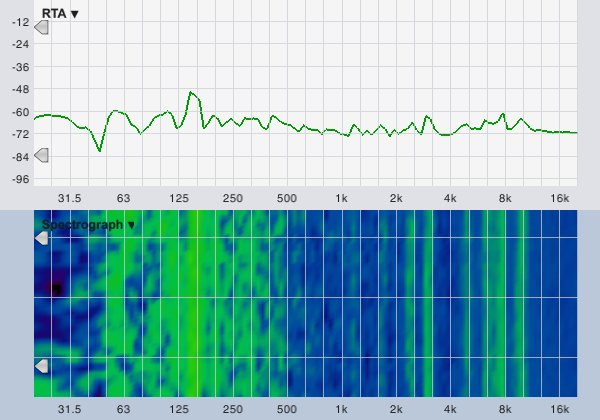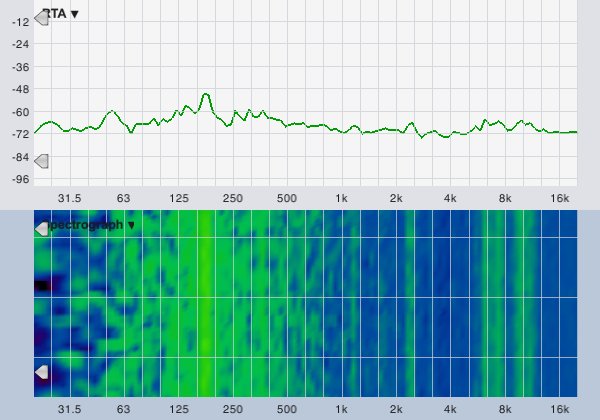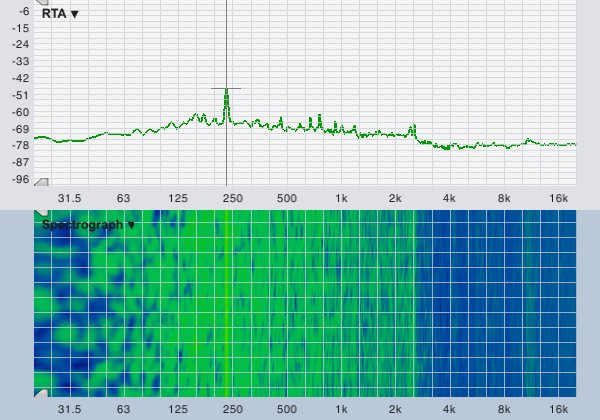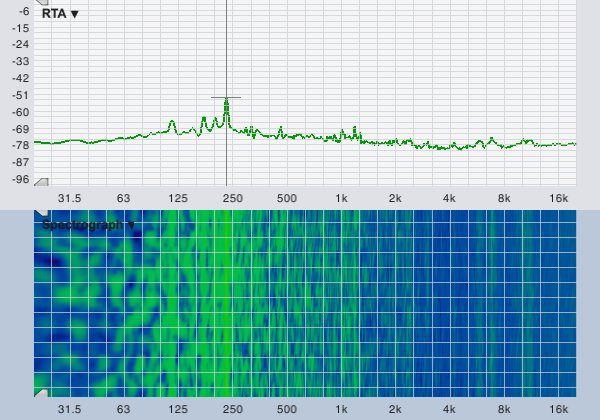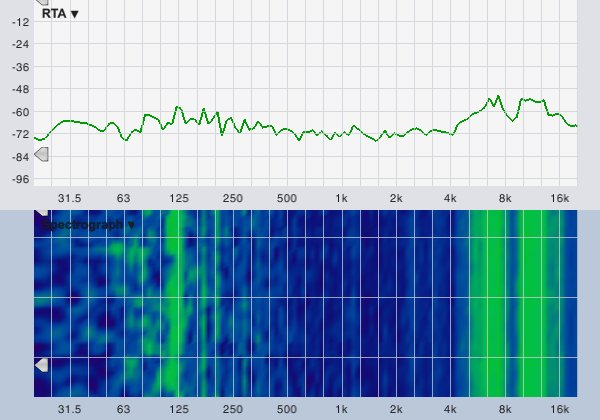Nvidia GeForce GTX 960: Maxwell In The Middle
Noise Level And Frequency Analysis
Noise
Will we have better luck with Nvidia’s new graphics cards than we’ve had in the past? It turns out that the answer to this question is a resounding yes! For this reason, we decided to forgo our usual comparison videos. The overall volumes of all the graphics cards are very low, and the differences between them are very small. Some of the fans are actually so quiet that we could measure the voltage converters’ noise, which is usually drowned out by them.
The overall noise level of the graphics cards might be the same, but the character of that noise most certainly isn’t. Every card produces a fairly wide assortment of noises, ultimately combining motor, fan (turbulence and airflow), as well as coil and capacitor (“whining”) noises into one overall sound characteristic. This is why we’ll try to make the measurement results for all individual graphics cards more meaningful by supplementing the rather neutral dB(A) values with a frequency analysis.
We’re using a high-quality studio microphone for our measurements and Smaart 7 for the data analysis. As usual, we measure from a distance of 50 cm perpendicular to the center of the graphics card in question. The ambient noise never exceeded 26 dB when we measured at night, and it was recorded and taken into account for each individual measurement.
The Secret Behind the Semi-Passive Mode
The following table shows a comparison of Nvidia’s default switching points, at which the fans are turned on and off. It also shows how Gigabyte made changes to these points for one of their graphics card models. To truly understand what’s going on, you need to know that the switching points are based on the GPU’s temperature, the voltage converter load, and, finally, hysteresis, which is to say that past performance is taken into account. The limits based on the power draw assume a good cooling solution. We’ll talk more about this in just a bit. In any case, it’s important that the VRM isn’t preheated in passive mode, since its capacitors don’t actually have any temperature sensors. This is why the load serves as an estimate instead.
But let’s go back to possible deviations. For example, the Gigabyte GTX 960 WindForce OC turned out to be unique in this regard during our tests. When asked, Gigabyte told us that this was their so-called “Silent Mode.” We’ve already seen its consequences when we looked at the voltage converter temperatures on the previous page: The fans rev up a lot earlier.
| Action | Description | Switching Points |
|---|---|---|
| <T-ON> | Fan On by Temperature (℃) | 69 (Nvidia Default)62 (Gigabyte GTX 960 WindForce OC) |
| <T-OFF> | Fan Off by Temperature (℃) | 43 (Nvidia Default) |
| <P-ON> | Fan On by Power (W) | 60 (Nvidia Default) |
| <P-OFF> | Fan Off by Power (W) | 32 (Nvidia Default) |
Here are the measurement results of all the graphics cards in this test summarized in one table. Measurements were conducted at an ambient temperature of 22 degrees Celsius.
| Model | Idle | Gaming Loop | Torture |
|---|---|---|---|
| Asus GTX 960 StriX OC | Fan Off | 33.6 dB(A) | 35.8 dB(A) |
| Gainward GTX 960 Phantom OC | Fan Off | 33.6 dB(A) | 35.9 dB(A) |
| Galax/KFA² GTX 960 EX OC | Fan Off | 35.1 dB(A) | 36.2 dB(A) |
| Gigabyte GTX 960 WindForce OC | Fan Off | 33.4 dB(A) | 35.8 dB(A) |
| Gigabyte GTX 960 Gaming G1 | Fan Off | 34.4 dB(A) | 34.6 dB(A) |
| inno3D GTX 960 iChill | Fan Off | 35.3 dB(A) | 36.4 dB(A) |
| Palit GTX 960 Super JetStream | Fan Off | 36.2 dB(A) | 36.6 dB(A) |
Operating Noise Analysis
We now come to the previously-mentioned frequency spectrums of each individual graphics card in this test during gaming and torture loads. We’ve included a detailed analysis as well.
Get Tom's Hardware's best news and in-depth reviews, straight to your inbox.
Asus GTX 960 Strix
During the gaming loop, we just see the motor noise of the slowly revolving fans and a bit of turbulence at approximately 200 Hz. The voltage converters don’t play a role here and the overall character of the noise is very balanced and pleasant.
Under full load, the noises produced by the fans’ blades and the airflow dominate. The voltage converters play a very minor role at just under 6 kHz. Together, this makes for a well-executed and unobtrusive cooling solution.
Gainward GTX 960 Phantom OC
This graphics card suffers from the design of its cooling solution, which places the fans between the cooler’s fins and the board and also has a cover that’s almost completely closed. The frequency of the ensuing noise is fairly low. This noise might be transferred to the PC case, since graphics cards are usually screwed on tight. The case then might resonate with it, which would be a very undesirable outcome, of course. Lesser whining noises from the voltage converters show up at approximately 7 kHz and can be measured easily. The turbulence isn’t really annoying from the outside, but the motor noises do produce very a noticeable and distinctive sound.
This sound get even louder under full load, and the voltage converters become more noticeable as well.
Galax/KFA² GTX 960 EX OC
We measure (and hear) both the fans’ motors at approximately 200 Hz and some minor turbulence. In addition, there’s the “electrical noise” of the voltage converters, which can also be both measured and heard at almost 7 kHz and also just above 10 kHz. The 3+1 phase design shows its flaws here.
Both turbulence and coil whining increase noticeably (and audibly) at full load. Overall, the card isn’t really all that loud, which is an observation backed up by the measurement results, but it can certainly be noticeable even after closing the case.
Gigabyte GTX 960 WindForce OC
The relatively open cover of this graphics card, as well as its fan placement, have us measure primarily motor, turbulence, and airflow noises. These yield a broad spectrum of frequencies, while staying pleasantly quiet overall. The voltage converters don’t make themselves known at all, which should be due to the 5+1 phase design. Moreover, these noises are more easily controlled by a PC case than deep resonances or high coil whine.
Even during the stress test, all that’s audible are the now somewhat louder fan noises of the now somewhat faster-spinning fans. The voltage converters stay on the sidelines.
Gigabyte GTX 960 Gaming G1
This graphics card’s performance results are counterintuitive. Voltage converter noise is audible during the gaming loop, but decreases with increasing constant load all the way to becoming inaudible. Three fans will always create a certain amount of noise no matter how low their RPM, but complaining about this is really just nitpicking.
Under full load, the fan noise increases marginally, but the card stays pleasantly restrained.
inno3D GTX 960 iChill
This graphics card cools like there’s no tomorrow. This does impact the noise level a bit during gaming operation, but it still manages to stay in the moderate range. The coils are dead quiet.
Under load, the noise produced by the fans is still all the noise that there is. Cool as ice and without any annoying coil whining: This is all that anyone can really ask for!
Palit GTX 960 Super JetStream
Sharing a space with the Palit GTX 960 Super JetStream could be such a good experience if it wasn’t for the coils. The fans spin very slowly during gaming and produce a noise at around 120 Hz. The voltage converter noises at 7 and 10 kHz are enough to really ruin the experience, though.
The same is true for full load. The motor noise at approximately 150 Hz is barely audible, but the voltage converter’s whining is just horrible.
Bottom Line So Far
Overall, finding a good cooling solution for the average waste heat of up to 100 W during gaming has been a successful endeavor for all manufacturers. Operating a graphics card like the ones tested doesn’t have to result in a noisy system anymore. The only caveat to this are the noises from the power converters, which, depending on the model and the design of the power supply, can be really annoying. This is the same problem we encountered with the GeForce GTX 970.
Current page: Noise Level And Frequency Analysis
Prev Page Temperatures Next Page Maxwell’s Efficiency Arrives At The Mid-RangeDon Woligroski was a former senior hardware editor for Tom's Hardware. He has covered a wide range of PC hardware topics, including CPUs, GPUs, system building, and emerging technologies.
-
Novuake This seems meh... Impressive but not phenomenal power consumption to performance numbers. Especially compared the GTX970/980.Reply
Would have liked to see two more things.
1. More extensive AA. post processing and memory bandwidth testing. Pretty sure Nvidia hamstrung the card a bit in some scenarios with a 1280bit interface. I had to read it 4 times before I believed it and still am skeptical.
2. Overclocking benchies.
So otherwise I guess we are back to the "old" ti-designation setup where the GTX960ti SHOULD be based on GM206 and vanilla GTX960 is not. -
sconzen I may be blind, but I don't see the Zotax Amp! edition in the temperature and noise tests. Confirm?Reply -
damric The R9 280 is the fast and cheap elephant in the room that was never mentioned in this review,Reply -
Grognak Well, I'm not saying a 10% improvement on top of a reduced power consumption isn't nice, because it really is, however we're still quite far away from the 770. I suppose Nvidia has a card planned to fill the massive performance gap between the 960 and 970, one at 4Gb of VRAM maybe?Reply -
sconzen I may be blind, but I don't see the Zotax Amp! edition in the temperature and noise tests. Confirm?Reply -
Novuake Reply15117694 said:The damn arrows are STILL blocking the charts!
I am not the only one! Thank you! -
ykki Novoake, I am very sorry but I stole your comment from an earlier review.Reply
But seriously, those arrows can block out the sun if tom's put 'em right.

